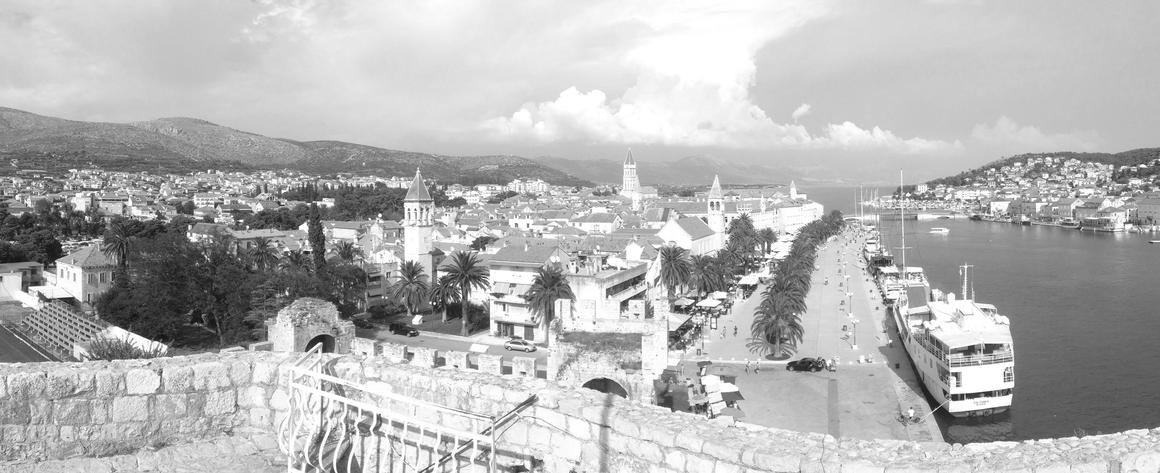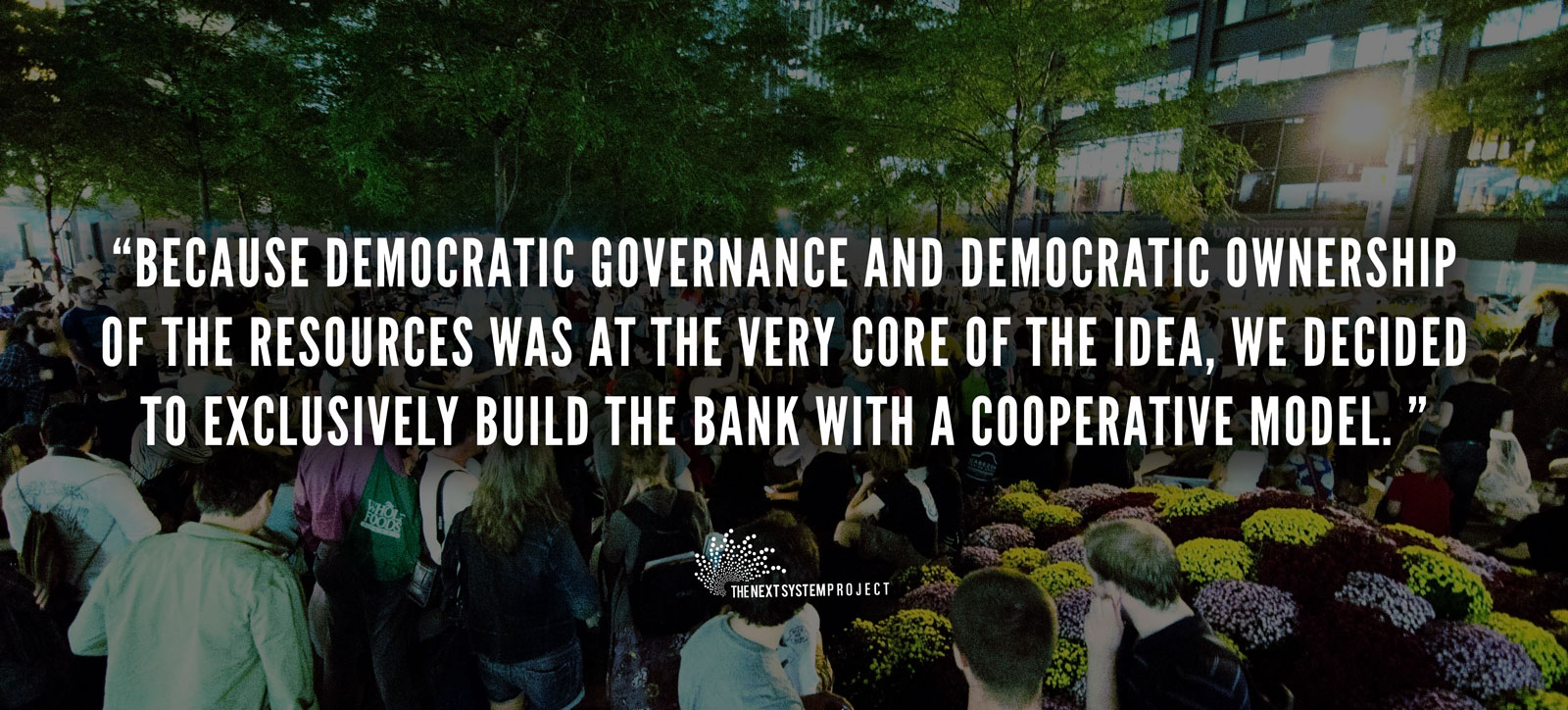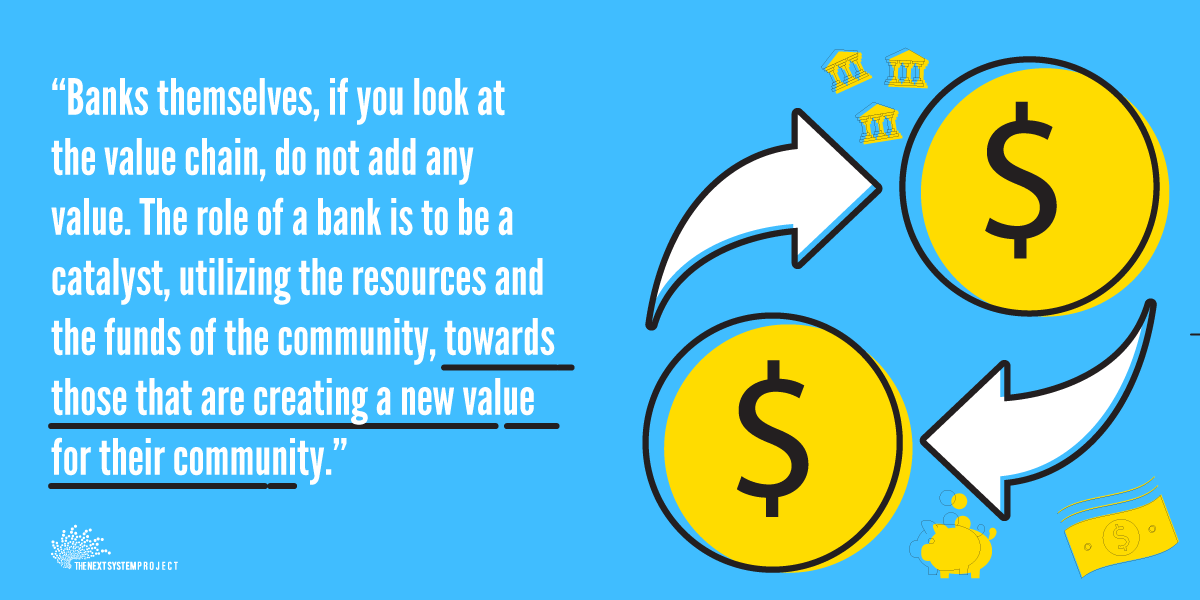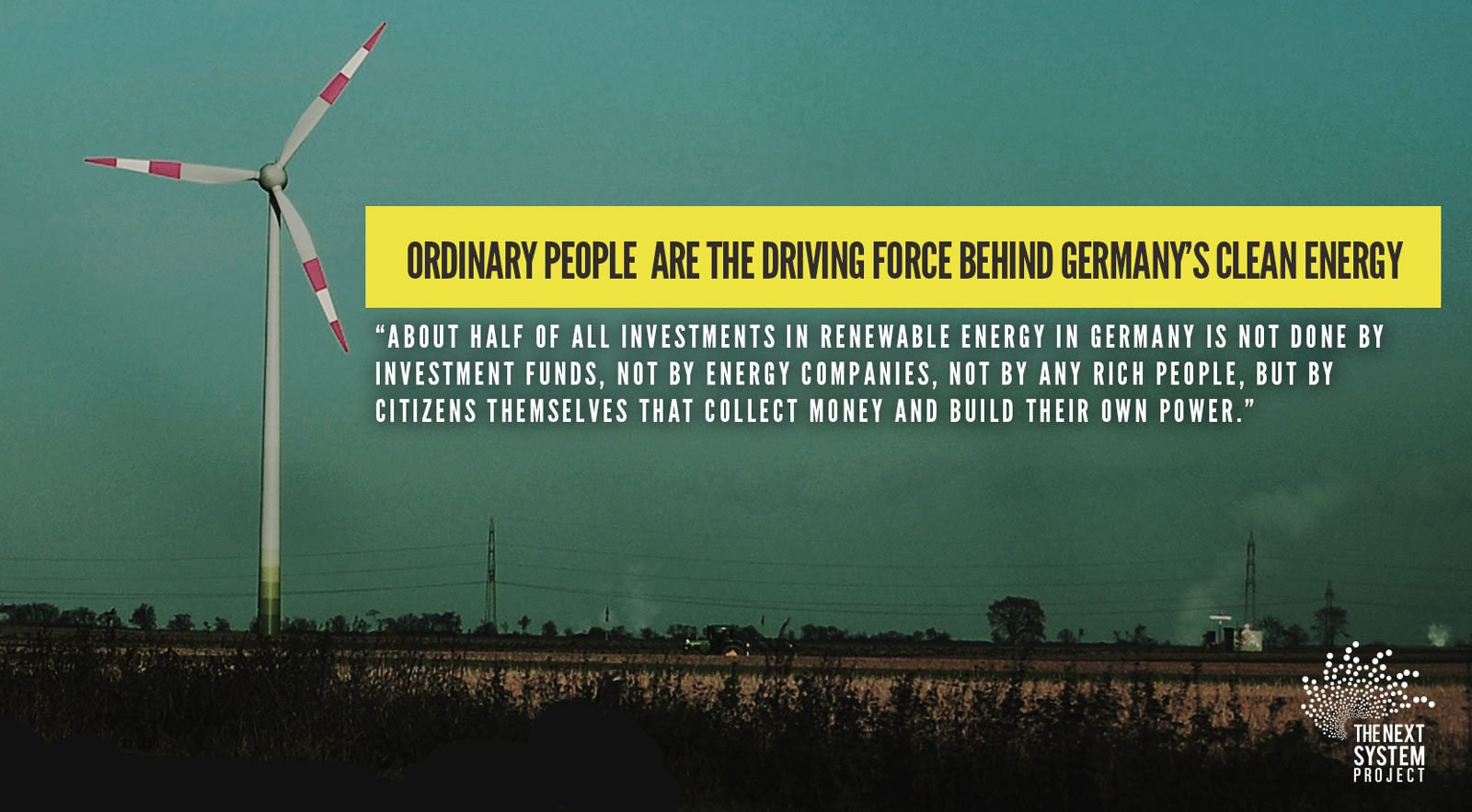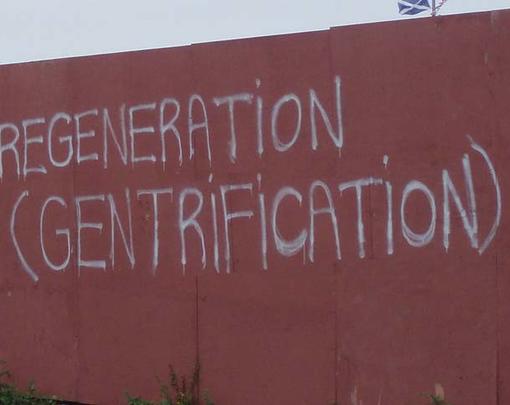The Democracy Collaborative’s Adam Simpson and Sarah McKinley sat down with Goran Jeras, one of the lead developers of ebanka, an ethical bank project launching in Croatia, for a conversation about building the institutions of an ethical and sustainable financial system.
Adam Simpson: Goran, thank you for joining us today. You are the cooperative manager of the Cooperative for Ethical Financing in Croatia. Can you tell us about the process of where this idea came from and how the Cooperative was started?
Goran Jeras: If you look at the origins of the idea, it has been about six years since this initiative started emerging. As all other ideas, it started as a talk over a beer. At that time, I was working in the Netherlands as a consultant, consulting with big international financial institutions, so big international banks, insurance companies, etc. It was just the beginning of the 2008 financial crisis, and my job focused on improving the risk-assessment methodologies that banks were using—because, obviously, they were wrong.
Through that process, I realized that the mainstream financial sector as we have it today is totally unsustainable from any possible perspective, be it financial, social, ecological, etc. The economy is powered by purely financial returns and profits, and this is as unsustainable as the financial sector which drives it.
It turned out that some of my friends who were living in Croatia were having similar thoughts, and we started developing the academic banking/financial model that would better suit the needs of communities, of societies, of people, of planned ecologies. At some point we had developed a model, which turned out to be very interesting for people that are already engaged in that kind of thinking: those interested in alternative economies, alternative banks, and social development cooperatives, which are very powerful in many European countries.
I resigned and moved back to Croatia. Together with those friends we started to actively promote our idea among all different stakeholders and groups in Croatia, and after two or three years of “missionary work,” going around and preaching a new idea, we found out that many stakeholders were intrigued.
Adam Simpson: They seemed to be looking for a model like this?
Goran Jeras: Absolutely. And because democratic governance and democratic ownership of the resources was at the very core of the idea, we decided to exclusively build the bank with a cooperative model. We invited almost a thousand of those stakeholders to join a foundation. We ended up with some 250 people in the room. We founded a cooperative which then started to do what’s necessary to start up the banking model.
Adam Simpson: In your own words, how would you define ethical banking? And how does it differentiate from traditional banks?
Goran Jeras: I wouldn’t use the word “traditional” because I think that banks started as a very similar institution to what we’re doing, so to some extent back it’s to the roots. Because the banks were not usually founded by rich guys that wanted to control the world. Typically, they were founded by people that didn’t have enough money, who wanted to pool their resources in one way or another. There is a definition of an ethical bank that we refer to. An ethical bank needs to have the following characteristics:
- It needs to be fully owned by its customers, so there are no shareholders in a bank who don’t have also interesting in services the bank is providing.
- It needs to be democratically governed, for instance, one member or one principal regardless of the amount of the capital that the member in the bank possesses.
- There must be an equal emphasis on the importance balance between financial, social, and environmental goals. All three aspects of an investment of the ethical bank needs to be positive, and finally from our part in that it needs to be local.
- The bank needs to keep and maintain an individual relationship with all its clients and customers, which isn’t possible if it becomes a big international institution.
- Transparency is also important. The role of the bank is to manage other people’s funds, so those people have every right to exactly know where their money is going and why it is going there, why it is assessed to be a good thing the three abovementioned aspects.
Our model of growth is based on expanding the model to different communities, sharing the costs of infrastructure, establishing common investment and collaboration schemes for areas of mutual interest, but to keep governance independence at the local levels. We think that is very important.
Adam Simpson: In many cases when we think about how banks operate there is a conception of a fiduciary duty. What is your understanding of the purpose of a bank?
Goran Jeras: The purpose of the bank is to efficiently manage the resources of the local community. Banks themselves, if you look at the value chain, do not add any value. The role of a bank is to be a catalyst, utilizing the resources and the funds of the community, towards those that are creating a new value for their community. Therefore, one of the elements in our model, which is also not present in more typical banks is that the bank itself should function as a nonprofit. Because if the bank takes a profit, it’s taken at the expense of those that are creating new added value.
We don’t want to do that. We want to facilitate access to resources to those that are creating new added value—meaning not only monetary value, but also social and environment value, etc. When they succeed, and create this added value, then they should return a percentage of that newly created value (depending on the risk of the project and other circumstances) back to the cooperative to be reinvested again because they were supported by the community. The cooperative itself is not for profit, it is just covering its operational costs. The extra income is coming from the percentage of the newly created value. This is the model of growth for a new investment and new services that the bank will make.
Adam Simpson: But in terms of how it compares to other banks with respect to services, it takes deposits, it makes loans?
Goran Jeras: It should be the only bank that somebody needs to have, taking deposits, making loans, and everything, but with some particularities in the whole thing. For example, there are no non-purpose consumer loans, because consumer loans from the perspective of ethical banking is only leading to a debt and not creating any added value. There are loans to individuals for something which is satisfying some basic human needs, like for education, for health, for a place to live, accommodation, for getting out of the social problems of social loans. But there wouldn’t be loans made who says, for example, “I have a credit card right now…” or “I have a salary which is so high that I’m allowed to get a certain amount of credit…” Basically we want to find a financial mechanism that would help people get out of this circle of indebtedness in which they are falling into.
According to other services, we not only think that we can provide most of the services that other banks are offering, but to go a few steps further. For example, crowdfunding. Crowdfunding is something which I see is a result of banks not doing their job properly: people unable to find a bank to invest the way they want, peer-to-peer lending, etc. While other ordinary banks see this as competition because now there are institutions other than themselves doing the job of the bank. We see it as something which we should implement in our business model because we could give this lending an additional level of trust and security, and reduced risks of people investing in it.
For example, when we get the project finalized, we do everything that banks do. We create a profile, risk assessments, analysis, etc., and before we give our own funds as a bank we offer it to our cooperative members on an internal crowdfunding platform, so you can invest into this project if you like. If a borrower doesn’t collect enough funds from the cooperative members we’ll top it off with the funds that are missing, because if we already approved the project, we’ll monitor it, we’ll follow it up, we’ll take care of the cash flow. We’ll provide loan financial services through the cooperative so that our risk is lower, but if you invest into the bank, pay into the project that you liked, then you get a return according to the success of the project.
By your investment in the bank you’re not getting anything. For example, when it comes to deposits there’s a 0% interest rate, so it saves the 0% interest rate so we as a bank we are saving your money, keeping your money safe. If you want to earn something on your money then you have your own project, then we can help you to get it financed and you develop it, or you have extra money that you want to invest on, we help you to find individual projects. We help you facilitate the whole process and you earn according to the success of that project.
Adam Simpson: My next question was actually about the structure of the bank and how it works as a cooperative. You answered it partially, but maybe there is something more you want to say about how to democratically set up a bank.
Goran Jeras: It depends on the legislation. I suppose it’s different in almost every country. In Croatia, for example, it is not possible to have a cooperative bank. Our solution to that problem was that we would have two legal entities. We have a cooperative which will own the bank as the 100% shareholder, [but nevertheless, two separate entities]. Relationships between cooperatives members are one-to-one, then translated to the bank which is just a service to the cooperative.
In other countries this is easier, because banks there could also be cooperative banks. However, now that we have this model of two entities we actually think that maybe it’s a better model, because it’s very clearly putting the bank in a position of service to a cooperative. So it’s very visible that the cooperative is the one which is more important in the bank.
This model also very clearly divides the roles. The cooperative is not there because of the banking services. A cooperative is there to do what cooperatives do: connect people, manage their resources together, connect them with some special expertise, to help them to collaborate, open markets for each other, etc. That’s something which is very useful for a bank as well, because you have an institution which can assist and solve business problems as it’s reducing the risk for you as a bank. The bank is doing financial stuff while the cooperative provides non-financial support, which is helping the businesses to succeed and reducing the risk for a bank.
Sarah McKinley: It’s just interesting what you said about separating out the services, because here our traditional cooperative banks are credit unions. And what can happen for some credit unions is that the banking services become far more important than what they’re supposed to be doing in terms of the mission. Then you also lose the democratic participation that you have in a cooperative model, so that’s an interesting structure.
Goran Jeras: It was quite accidental. We were thinking that it’s just a legal workaround to make it work in Croatia, but then suddenly we realized, “Oh, it’s actually very smart,” because it’s clearly dividing the functions. It is keeping banking under control, so the cooperative is the owner and those are just the service providers, and regardless how financially powerful they are it’s clear that in this structure the cooperative is ruling the whole thing.
We were researching why banks that have started as some kind of the community banks, cooperative bank movements, why there are many cases where they turned out to become just normal commercial banks. Our conclusion is that they have become too big, and they came to a level where they couldn’t keep the individual relations with every client, every cooperative member. When you have such a situation you must atomize your processes. You put your clients in different baskets, and in that process, lose sight of your mission. You lose more and more information.
There is the concept of cybernetics, a discipline in mathematics, which is deals with systems. There is a simple conclusion which is fantastically logical—I don’t know why it’s not used more frequently. Each system has a limit until which it can sustain itself while monitoring all its function, but the moment it exceeds that limit—it becomes too complex—then there are two ways how the system can expand. It can build in a hierarchical way by creating a system which is above another and takes over some responsibilities. This is how all classical corporations are built, and most of human existence, but in that process you always have a loss of information.
Between different layers of hierarchy usually around 50% of information is lost, so at the top you don’t really know what is happening at bottom. But how the nature does it, nature splits systems, so when it comes to the size where the system cannot sustain itself, it splits into two independent systems, and then your complexity is reduced by half. It’s used all over in nature and in many manufacturing processes, but not so much in the social relationship and building of complex nontechnical institutions, governance, etc. We said, “Okay, we are not going to make the same mistake, but design a system which by definition has a limited size,” and in banking we did some simulations.
It looks that the limit for our model is something between 60,000-100,000 customers, after which you just cannot do all the processes that you would need to do as a bank. It obviously depends on many factors however.
Adam Simpson: What are some of the criteria that informs your investments?
Goran Jeras: We have a framework which is a social impact assessment framework. That was a pretty tough one to implement because there are different methodologies for the measurement of social impact, but all of those are long-term and quite expensive to utilize. So actually what we did: we cheated. We developed a methodology which is measuring only the social acceptance, so acceptance of your activities by the community, which can be measured much more quickly.
It’s a metric which has different elements, like awareness of all the ecological issues or pollution, sourcing of your materials that you’re using in your process, your approach to labor rights, involvement of workers in participating in the governance of your company, a fair distribution of profits, impact on the community, safety, so there are different criteria. Then this metrics basically results in a range of numbers but could be ultimately reduced to one total score, so if you look at those particular areas, neither of these particular parts of the metrics could be negative. And we have a threshold of how much points that project needs to score to be supported by the bank.
The higher it scores it gets better financing conditions from us, so it’s motivation for them to improve as well.
Adam Simpson: In Croatia, you couldn’t have a cooperative bank so it led you to set it up the unique way that you described, and it seems like there are social factors that might inform how this bank operates, but I’m wondering about the broader social and economic ecosystem that this model needs to flourish and to grow.
Goran Jeras: I think it can work everywhere, but obviously there are some aspects of help. For example, I was living in The Netherlands and this idea was mostly developed while I was already there, but the reason why I haven’t initiated in The Netherlands is because there is not so much need for such a bank. Why? Because they have already banks that are working similarly.
Adam Simpson: That’s something I read about: that the ethical banking model in some places is being taken on as part of a sense of professionalism of running a bank.
Goran Jeras: Yeah. It has different origins. It came out of ideology, out of actually faith, the religious aspect. Rudolf Steiner, this is a guy who had some special Protestant movement, called Anthroposophy. It brings certain values to the society and they wanted to have a bank that would operate according to their values. It turned out that those values are very close to universal humanist values because their inspiration was in religion. It’s not the only case. For example, Banca Etica in Italy, it was formed by the Catholic Church. Banking institutions were closed to the Catholic Church, but wanted also to have a financial institution that would follow up the social teachings of the Church.
Sarah McKinley: It’s like Islamic banking as well, where you can only have so much interest and packaged in certain ways as well.
Goran Jeras: Exactly. We were exploring that as well, Islamic finance. The element that we took from there is fair risk sharing. Where you go in there basically not calculating interest rates, but they treat every investment as a kind of a joint venture. If we as a bank are giving you money, you are bringing us an idea, you have some percentage in this, and as the project develops then we are taking our return based on the success of the project. It’s very good because then your interest is aligned. As a bank, you want the borrower to succeed and be as profitable as possible because you would earn more. I must say that I was quite amazed to see that if you look at the history of religion there is not even one which, in the original text and the original motivation, declares interest as a moral thing to do. So, earning money just based on the fact that you have money is seen morally dubious within religions.
Sarah McKinley: Usury.
Goran Jeras: Usury. Exactly. Except in Judaism where it was not, but Judaism has other elements. Every 7 years they have what’s called a Sabbatical, which cancels all debt that are accumulated up to that point, so they erase all debt every 7 years, and every 50 years they have the year of the Jubileum, which is erasing not only debt but also returning the property back to the original owner. You should not be punished because your father or grandfather made a mistake. You also get your land back and you don’t have to pay.
Adam Simpson: That’s fascinating.
Goran Jeras: Our model of banking became quite popular in some circles in Europe, and then at some point I got an invitation to France to a small place called Eze, and in this Eze there is some religious community, which is promoting a modest life, so basically the life based only on things that you can produce with your own hands. It’s really popular. There are tens of thousands of young people coming there every year and they spend some time living with those monks there. Those monks are organizing some international conference on solidarity. They invited us as speakers, and I was like, “What? Speakers about ethical banking in a monastery?” To me it was totally crazy, but it was so outside of the banking world that I decided to go just out of curiosity, and it turned out that it is a very communal place.
There are people of all different faiths. There are Buddhists, there are Jews, there were Christians, Orthodox, so all different people talking about common things that are a problem to all of us. Actually, all the feedback that I got about the religious view I got there.
Sarah McKinley: Of course a monk or a priest started the Mondragon Cooperatives in Spain, so there is a lot of religious underpinning to a lot of this work.
Goran Jeras: Of course. Yeah. Sure. To me wherever you find your inspiration is fine.
Adam Simpson: Looking into the banking system, everyone is saying that Fintech will be the biggest disruptor to the financial system.
Goran Jeras: I think there is one major flaw with most of the Fintech solutions that I think I have seen up to now, and that they are focused on consumers. They’re enabling people to construct all different spending schemes, and very little of Fintech is oriented towards the production, manufacturing, the utilizing of funds, crowdfunding. Have you ever heard of anything crowdfunded which was in the form of a factory or something like that?
Adam Simpson: No, I normally hear about an artist or a musician.
Goran Jeras: Yeah, and that’s all nice but the real economy needs to have this as well. Fintech needs to impact food production, some basic raw materials and stuff, and Fintech just doesn’t… What Fintech allows, Fintech allows people to take control over their own money but it doesn’t allow generally lending that money to anything more sophisticated. That I see as a problem.
Sarah McKinley: Have you heard of a model in Seattle called Community Sourced Capital? It’s an effort to create a crowdsourcing platform but have it be investing directly into bricks and mortar stuff that exists in the world.
Goran Jeras: To me, if I look on this very strategy level, my huge inspiration is a guy developing an open-source ecology project, which is creating something that he calls Global Village Construction Kit. Basically the guy has an organization which is trying to develop 50 industrial-ready machines, so a set of 50 machines with which, if you have these 50 machines you would be able to create civilization from scratch. They produce everything that exist with a combination of those 50 machines, and of course some raw materials, but those machines also could be used to produce raw materials. His ideas is to develop those machines as an open-source concept, so to allow it to be easily replicated.
It should work as a Lego brick, so you have an engine of one machine they are putting in another, and then they could very much reuse them. Not a single one of those machines should cost in its production of the current prices more than $1,000. If you would basically like to have a set of machines with $50,000. To me that’s some kind of the economy which makes much more sense, because currently globalization, this economy of scale, we have an economy which is extracting the resources of one part of the planet and bringing them to another, China, or somewhere, then producing millions of copies of something and then distributing all around the world.
They are claiming that it is the most efficient way to do this. I am a physicist by training, and I don’t buy this. Efficiency is energy and they spend so much of the energy in transportation without considering the cost of externalities. It cannot be the most efficient way.
Basically that’s a fight against externalities because there are a lot of hidden costs that are not now seen in the price of the TV, but are already made in environmental costs, social exploitation, all those kind of things, but if we would count the data and compare definitely with this model it would be much more efficient. The first step toward that kind of economy in Europe, in my view, has been done by energy cooperatives. I don’t know if you have it here in the States, but what happened with the energy cooperatives, first because of the climate change all European countries wanted to invest in renewable energy of all size so it was heavily subsidized. It turned out that the initial beneficiaries were just the big companies that then said, “Okay, if the government is paying for me to have a solar panel or wind power, why wouldn’t I do that?”
And they invested in it, but very soon citizens, people realized, “Hmmm, why would I have a wind turbine in my backyard which is making this funny noise, and I don’t know, I cannot sleep. If I can collect money together with my neighbors and have another wind turbine down there, and actually the government is paying for it. I am giving guaranteed money back. I am saving electricity. I don’t have a risk of electricity price increase because it’s my own power. First I use it myself and what is the rest then it goes. Why wouldn’t we do that?” They started building cooperatives, which started investing in renewable energy of all kind.
Very quickly it turned out that this is actually an easier way to green the energy sector because when people are the owners, then they have the benefits, and it’s much easier to get all permits rights because nobody is complaining, nobody is protesting. Initially then the companies started sharing, giving part of the share of the renewable energy to citizens, but then citizens took it over.
Currently, about half of all investments in renewable energy in Germany is not done by investment funds, not by energy companies, not by any rich people, but by citizens themselves that collect money and build their own power. It has become so big that companies are now trying to create political pressure and trying to eliminate all those incentives for renewable energy. In the meantime, the prices of everything have dropped so sharply that now you don’t need incentive anymore. Now it’s commercially viable to building power through solar, and it’s unstoppable. Now there is the Federation of Energy Cooperatives of Europe which is investing with their own money, extra cash without financing or anything in the wind power plants.
Then when you have such control over it, it’s democratic energy, and then energy for your own purposes is for free, because it’s your own energy. Here in the US it’s probably not so attractive anymore, but in my view the fossil fuels and the renewable energy, this is a battle that fossil fuels cannot win, not because of the quality but because of economics.
Sarah McKinley: Because of the economic outlook.
Goran Jeras: On one side you have something very unique to dig out of the ground and the more you dig the farther that you need to get, and costs rise. [For green energy] you have the cost of equipment, but the sun is not sending a bill, so basically the price of renewables goes like this [gestures that they will get exponentially cheaper], and the price of non-renewables goes like this [gestures that they will get exponentially more expensive] and they will cross sooner or later. That’s something that nobody can do anything about it.
Adam Simpson: The final thing that I’d want people to know if they were to read parts of this conversation, if they wanted to learn more about your work and the work that you’re working on or other, is there a website they can go to? Are the sources you can-
Goran Jeras: If you go to www.ebanka.eu, there is some information but very limited. We are building a new website that will be just for the replication of our model.
Adam Simpson: Thanks, Goran.


